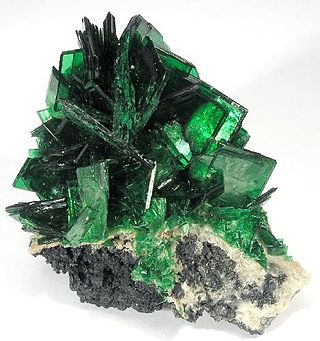
Torbernite, also known as chalcolite, is a relatively common mineral with the chemical formula Cu[(UO2)(PO4)]2(H2O)12. It is a radioactive, hydrated green copper uranyl phosphate, found in granites and other uranium-bearing deposits as a secondary mineral. The chemical formula of torbernite is similar to that of autunite in which a Cu2+ cation replaces a Ca2+ cation. Torbernite tends to dehydrate to metatorbernite with the sum formula Cu[(UO2)(PO4)]2(H2O)8.

Adamite is a zinc arsenate hydroxide mineral, Zn2AsO4OH. It is a mineral that typically occurs in the oxidized or weathered zone above zinc ore occurrences. Pure adamite is colorless, but usually it possess yellow color due to Fe compounds admixture. Tints of green also occur and are connected with copper substitutions in the mineral structure. Olivenite is a copper arsenate that is isostructural with adamite and there is considerable substitution between zinc and copper resulting in an intermediate called cuproadamite. Zincolivenite is a recently discovered mineral being an intermediate mineral with formula CuZn(AsO4)(OH). Manganese, cobalt, and nickel also substitute in the structure. An analogous zinc phosphate, tarbuttite, is known.

Eudialyte, whose name derives from the Greek phrase Εὖ διάλυτος, eu dialytos, meaning "well decomposable", is a somewhat rare, nine member ring cyclosilicate mineral, which forms in alkaline igneous rocks, such as nepheline syenites. Its name alludes to its ready solubility in acid.

Olivenite is a copper arsenate mineral, formula Cu2AsO4OH. It crystallizes in the monoclinic system (pseudo-orthorhombic), and is sometimes found in small brilliant crystals of simple prismatic habit terminated by domal faces. More commonly, it occurs as globular aggregates of acicular crystals, these fibrous forms often having a velvety luster; sometimes it is lamellar in structure, or soft and earthy.

Triplite is a rare phosphate mineral with formula: (Mn, Fe)2PO4(F, OH). It occurs in phosphate-rich granitic pegmatites typically as irregular brown opaque masses. Triplite was first described in 1813 for an occurrence in Chanteloube, Limousin, France. The name is from the Greek triplos for triple, in reference to the three cleavage directions. In color and appearance, it is very similar to rhodocrosite, another manganese bearing mineral. Chemically, it is also quite similar to triploidite the difference being that triplite is fluorine dominant while triploidite is hydroxide dominant.
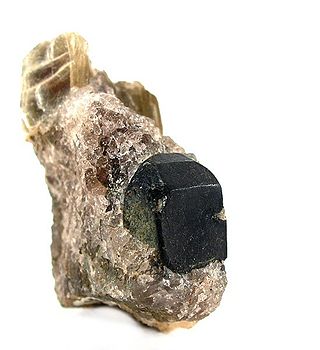
Triphylite is a lithium iron(II) phosphate mineral with the chemical formula LiFePO4. It is a member of the triphylite group and forms a complete solid solution series with the lithium manganese(II) phosphate, lithiophilite. Triphylite crystallizes in the orthorhombic crystal system. It rarely forms prismatic crystals and is more frequently found in hypidiomorphic rock. It is bluish- to greenish-gray in color, but upon alteration becomes brown to black.

Austinite is a member of the adelite-descloizite group, adelite subgroup, the zinc (Zn) end member of the copper-Zn series with conichalcite. It is the zinc analogue of cobaltaustinite and nickelaustinite. At one time “brickerite” was thought to be a different species, but it is now considered to be identical to austinite. Austinite is named in honour of Austin Flint Rogers (1877–1957), American mineralogist from Stanford University, California, US.
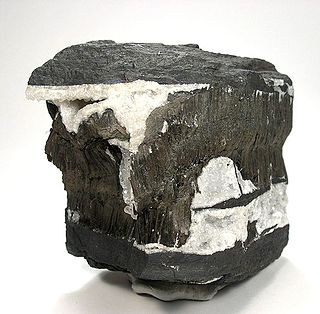
Todorokite is a complex hydrous manganese oxide mineral with generic chemical formula (Na,Ca,K,Ba,Sr)
1-x(Mn,Mg,Al)
6O
12·3-4H
2O. It was named in 1934 for the type locality, the Todoroki mine, Hokkaido, Japan. It belongs to the prismatic class 2/m of the monoclinic crystal system, but the angle β between the a and c axes is close to 90°, making it seem orthorhombic. It is a brown to black mineral which occurs in massive or tuberose forms. It is quite soft with a Mohs hardness of 1.5, and a specific gravity of 3.49 - 3.82. It is a component of deep ocean basin manganese nodules.

Triploidite is an uncommon manganese iron phosphate mineral with formula: (Mn, Fe)2PO4OH. It crystallizes in the monoclinic crystal system and typically occurs as elongated and striated slender prisms which may be columnar to fibrous. Its crystals may be pinkish to yellowish brown or red-orange.

Seamanite, named for discoverer Arthur E. Seaman, is a rare manganese boron phosphate mineral with formula Mn3[B(OH)4](PO4)(OH)2. The yellow to pink mineral occurs as small, needle-shaped crystals. It was first discovered in 1917 from a mine in Iron County, Michigan, United States and identified in 1930. As of 2012, seamanite is known from four sites in Michigan and South Australia.
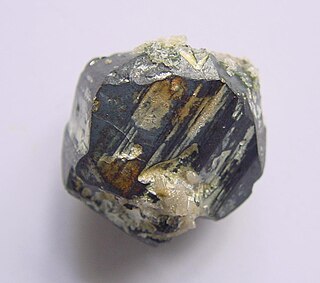
Djurleite is a copper sulfide mineral of secondary origin with formula Cu31S16 that crystallizes with monoclinic-prismatic symmetry. It is typically massive in form, but does at times develop thin tabular to prismatic crystals. It occurs with other supergene minerals such as chalcocite, covellite and digenite in the enriched zone of copper orebodies. It is a member of the chalcocite group, and very similar to chalcocite, Cu2S, in its composition and properties, but the two minerals can be distinguished from each other by x-ray powder diffraction. Intergrowths and transformations between djurleite, digenite and chalcocite are common. Many of the reported associations of digenite and djurleite, however, identified by powder diffraction, could be anilite and djurleite, as anilite transforms to digenite during grinding.
Schreyerite (V2Ti3O9), is a vanadium, titanium oxide mineral found in the Lasamba Hill, Kwale district in Coast Province, Kenya. It is polymorphous with kyzylkumite.

Beraunite is an iron phosphate mineral. It was first described by August Breithaupt for an occurrence in Beraun currently in the Czech Republic. Beraunite occurs as a secondary mineral in iron ore deposits, and as an alteration product of primary phosphate minerals in granite pegmatites.

Cyrilovite (NaFe33+(PO4)2(OH)4·2(H2O)) is a hydrous sodium iron phosphate mineral. It is isomorphous and isostructural with wardite, the sodium aluminium counterpart.

Hureaulite is a manganese phosphate with the formula Mn2+5(PO3OH)2(PO4)2·4H2O. It was discovered in 1825 and named in 1826 for the type locality, Les Hureaux, Saint-Sylvestre, Haute-Vienne, Limousin, France. It is sometimes written as huréaulite, but the IMA does not recommend this for English language text.

Minyulite is a rare phosphate mineral with a chemical formula of KAl2(PO4)2F·4(H2O).

Allanpringite is a phosphate mineral named after Australian mineralogist Allan Pring of the South Australian Museum. Allanpringite is a Fe3+ analogue Al-phosphate mineral wavellite, but it has a different crystal symmetry – monoclinic instead of orthorhombic in wavellite. It forms needle-like crystals, which are always twinned and form parallel bundles up to about 2 mm long. They are often found in association with other iron phosphates in abandoned iron mines.
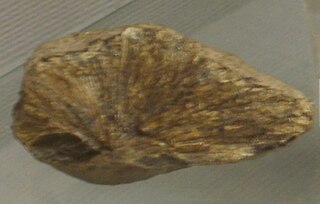
Satterlyite is a hydroxyl bearing iron phosphate mineral. The mineral can be found in phosphatic shales and was first discovered in the Big Fish River area in Yukon Territory, Canada.
Gatehouseite is a manganese hydroxy phosphate mineral with formula Mn5(PO4)2(OH)4. First discovered in 1987, it was identified as a new mineral species in 1992 and named for Bryan M. K. C. Gatehouse (born 1932). As of 2012, it is known from only one mine in South Australia.
Zincoberaunite is an iron and zinc phosphate mineral, the Zn analogue of beraunite. It was first described by Chukanov et al. for an occurrence in Hagendorf Sud pegmatite in Germany. Zincoberaunite occurs as a secondary mineral as an alteration product of primary phosphate minerals in granite pegmatites.

















